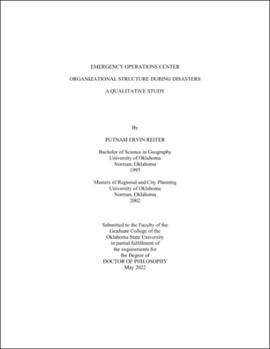| dc.contributor.advisor | Chang, Ray | |
| dc.contributor.author | Reiter, Putnam Ervin | |
| dc.date.accessioned | 2023-03-16T21:14:18Z | |
| dc.date.available | 2023-03-16T21:14:18Z | |
| dc.date.issued | 2022-05 | |
| dc.identifier.uri | https://hdl.handle.net/11244/337117 | |
| dc.description.abstract | This dissertation explores the State of Oklahoma Emergency Operations Center (EOC) organizational structure before and during disaster response. I utilized the lens of contingency theory to review prior EOC research and linked it with mechanistic and organic structures. After the review of literature, I developed the following research question: in what ways is a state-level emergency operations center (EOC) mechanistic or organic, and how do these organizational constructs influence disaster response? | |
| dc.description.abstract | I utilized two methodological analyses to answer this research question. Content analysis is the first methodology I employed. Subsequently I analyzed three training documents from the federal government and one planning document from the State of Oklahoma. My analysis of the four documents revealed: 1) EOC organization swings between mechanistic and organic, 2) there are hidden organic structural elements, and 3) staff networking is essential. To better explore these three concepts, I conducted a second methodology involving semi-structured qualitative interviews. I used grounded theory methodology (GTM) and data driven codes to interpret the interview data. Interview results demonstrated 1) EOCs are dynamic organizations, 2) environmental cues are vital to staff completing their job, and 3) staff networking leads to relationship building and trust. | |
| dc.description.abstract | Utilizing the literature I reviewed and the two qualitative analyses I conducted, I arrived at four suggestions: 1) training documents should illustrate EOC structure as dynamic, 2) networking among staff allows for trust and coordination, 3) staff refine their role during disasters and throughout the next disaster, and 4) staff must learn the hidden organic elements of the EOC. I combined all these elements into suggestions for future scholarly research on EOCs. | |
| dc.format | application/pdf | |
| dc.language | en_US | |
| dc.rights | Copyright is held by the author who has granted the Oklahoma State University Library the non-exclusive right to share this material in its institutional repository. Contact Digital Library Services at lib-dls@okstate.edu or 405-744-9161 for the permission policy on the use, reproduction or distribution of this material. | |
| dc.title | Emergency operations center organizational structure during disasters a qualitative study | |
| dc.contributor.committeeMember | Brienen, Marten | |
| dc.contributor.committeeMember | Wu, Tristen | |
| dc.contributor.committeeMember | Fullerton, Jami | |
| osu.filename | Reiter_okstate_0664D_17555.pdf | |
| osu.accesstype | Open Access | |
| dc.type.genre | Dissertation | |
| dc.type.material | Text | |
| dc.subject.keywords | emergency management | |
| dc.subject.keywords | emergency operations center | |
| dc.subject.keywords | organizational structure | |
| thesis.degree.discipline | Fire and Emergency Management Administration | |
| thesis.degree.grantor | Oklahoma State University | |
